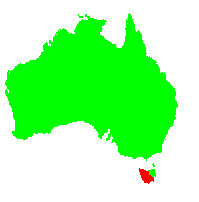General Description:
Phyllocladus aspleniifolius is a widespread coniferous tree which may reach as high as 20 metres. The common name, ‘celery-top’, is quaint and interesting! With a little imagination one can liken a stalk or bunch of celery to a celery-top tree and yet, again, the irregularly shaped ‘leaves’ of the celery plant do resemble (somewhat) those of the ‘pine’ of the same name! However, celery-top pine has no leaves, apart from some tiny, brownish, triangular scales on the younger twigs! So, what are those things that look like leaves? – green, leathery in texture, irregularly notched and more or less rhomboidal in shape. According to botanists those leaf-like organs are actually small, flattened twigs technically known as ‘cladodes’. They perform the same functions as leaves but are altogether quite different organs.
Celery-top pine does not bear cones in the accepted sense. Rather, the tiny blackish seeds are surrounded (but not completely so) by pink, fleshy scales and a fleshy white outgrowth of the seed called an aril. Those modified ‘cones’ usually occur in clusters of 3-4 and appear at the tips or upper margins of the cladodes.
Related to the Huon pine, celery-top pine is a very much more widespread and common tree. There are even records of its being found on Bishop and Clerk Mountain on Maria Island. It occurs in other widely separated localities as in parts of the north-east of Tasmania and on south Bruny Island, the Central Plateau and the Tasman Peninsula.
As with all our native conifers, celery-top pine does not tolerate fires at all well and will be eliminated from areas suffering increasingly frequent bushfires. This accounts for the absence of the species from Mount Wellington near Hobart where, once, it was presumably quite widespread! In areas of high rainfall and infrequent fires, celery-top pine may dominate understorey rain-forest species.
The timber, although not quite as durable as that of the Huon pine, is much used in boat building and furniture construction. Also it is now a popular, if expensive, durable and attractive cladding timber for house building purposes. In the past it was used for railway sleepers and mine pit-props.
Celery-top pine is easily grown and maintained in all but the driest and poorest of soils. The branching arrangement of the young tree is regular and symmetrical with the evenly tiered branches held horizontally to the trunk. This form of growth will continue as long as the terminal bud is not removed or damaged. Celery-top is a pleasing tree, perhaps better group planted, with each specimen of different height. As well, it will thrive and please in a large container and does not object to being somewhat ‘pot-bound’.
Propagation can be carried out from seed or from cuttings of the cladodes.

Foliage of Phyllocladus aspleniifolius
Photo: Cas Liber
 Australian Native Plants Society (Australia)
Australian Native Plants Society (Australia)













